
BY MARION WEBB
If you are an observing intern at a fitness facility, you may find yourself practicing what you’ve learned in the most unusual places.
Three months into my internship at Fitness Quest 10 (FQ10) in San Diego, I was visiting my dentist, with whom I share a passion for cycling. As such, our conversations always begin with an inquiry about my training or how I did in a recent race.
During this visit, however, his middle-aged assistant, Maria, chimed in about her walking regimen and her struggle to lose weight in the midsection. So I asked her if she did any strength-training. Next thing you know, the two of us were kneeling on the floor on our hands and feet practicing front and side planks and the bird-dog. You can imagine the stunned look on my dentist’s face as he reentered the exam room.
 Upon my follow-up appointment two weeks later, Maria was beaming as she proudly attested to practicing planks and bird-dogs every morning. It was great to see Maria’s big smile as I handed her some of ACE’s Fit Facts to keep her inspired, and also that of my doctor as I provided him with a few low-back exercises to address his flexibility issues.
Upon my follow-up appointment two weeks later, Maria was beaming as she proudly attested to practicing planks and bird-dogs every morning. It was great to see Maria’s big smile as I handed her some of ACE’s Fit Facts to keep her inspired, and also that of my doctor as I provided him with a few low-back exercises to address his flexibility issues.
Granted, as the managing editor of ACE, I am fortunate to learn about fitness trends on the job, but my internship gave me the confidence to put some of this knowledge into practice.
Putting Knowledge Into Practice
During my 60-hour internship at FQ10, I observed a strength and conditioning coach (who is also in charge of the health club’s internship program) practice variations of planks, dirty dogs and bird-dogs with clients of all ages, fitness levels and abilities.
I knew that practicing a front and side plank with bent knees would be a safe exercise for a beginner exerciser like Maria. While it is critical to gain foundational theoretical knowledge about exercise science and the functionality of the human body (such as exercise physiology, nutrition, anatomy and kinesiology), it has been quite enlightening to watch these top trainers in action.
FQ10 is a relatively small facility with seemingly well-to-do clients. Owner Todd Durkin (who was named the 2005 ACE Personal Trainer of the Year) strives to provide excellent service regardless of one’s fitness level. Widely known for training professional and varsity athletes looking for a competitive edge, FQ10 also caters to middle-aged professionals and young adults looking for a trimmer waistline or to simply improve their overall health and well-being.
But what does excellence mean, exactly? Indeed, many service providers proclaim to give excellent service, but few deliver.
What’s My Name?
At FQ10, great service starts with knowing the name of every client. Every FQ10 trainer and staff member makes an effort to say hello or wave to each person walking into the door. The same holds true for the interns. The staff gets to know every intern by name. Conversely, as an intern, I also was determined to learn the names and some personal facts about each trainer and the clients I interacted with.
At FQ10, it is not uncommon for trainers to rotate clients, which offers both parties the opportunity to explore different personality and training styles. Some clients seem to enjoy this approach. Many clients, however, have developed long-lasting relationships with one particular trainer, which becomes evident in terms of trust, the ease or joking ways of their interactions, and open style of conversations.
My favorite shadowing experience was a small group session comprised of three men or “the three amigos” as I named them. I say this with fondness, because in time, I looked forward to interacting with these three highly motivated and fun-loving guys: two middle-aged men and the 20-something son of one of the men, whose participation during their regular, twice-weekly sessions was always iffy.
This, of course, translated into the trainer’s need to improvise on the fly, and he did so seemingly effortlessly. Not only was the exercise routine different during each session, it was also creative and challenging. How the trainer managed to pull different exercises out of a hat like a magician was mind-boggling to both me and to the clients, who often praised (and sometimes cursed) the trainer and his ingenuity.
I overheard these types of comments often. Mostly, clients seemed to be in awe of these human exercise libraries, which was expressed in different ways, including: “Where do you come up with this stuff?”
Durkin’s goal is to create value for clients, so interns can shadow trainer-client sessions, but not train clients. This was the upfront agreement. Only once was I entrusted to demonstrate a TRX abdominal workout series to a client, which I had previously tested in a mock session with the trainer.
It is understandable that Durkin, whose business model is based on marketing personal training and small-group personal-training sessions to clients, wouldn’t want to risk losing clients who pay good money by allowing an intern to lead their exercise sessions. Hence, my internship (part of the University of California, San Diego Extension’s Professional Certificate in Fitness Instruction and Exercise Science), was based on learning by watching trainers interact with clients and taking notes.

If you want to be hired at a particular club or facility, this type of internship is a great way to get your foot in the door. After all, internships, paid or unpaid, offer advantages: You get to know the staff, trainers and clients, and gain an insider’s perspective of the overall operation as well as the chance to impress a potential future employer.
I later learned that several of Durkin’s staff trainers were former FQ10 interns themselves. It is my understanding that Durkin does not make hiring decisions lightly; some trainers told me they volunteered for several intense internships to improve their chances of being hired.
Getting to Know Personality Styles
At FQ10, I witnessed first-hand why ACE stresses to trainers the importance of developing good communication skills and being able to identify and adapt to various personality styles.
Trainers need to be highly adaptive, know how to improvise, and be quick on their feet. When multiple clients work with a trainer in a confined space, it is critical to pay extra attention and interact with those around you.
I have seen trainers revise planned workouts based on how a client feels that day, has a change in their health status, or arrives late for an appointment. For instance, I witnessed a college-aged, aspiring Olympic figure skater tell the trainer that his back was compromised from a recent fall on the ice. The injury was no longer acute, but in the post-rehab stage. He performed all exercises surprisingly well, even with loaded weights. Clearly, it takes experience to know how far to take a client when injury is a factor.
But even the most experienced trainers told me they would always refer an injured client to the in-house physical therapist or an appropriate health professional to stay within their scope of expertise.
The Fun Factor
FQ10’s seemingly high client-retention rate and loyal customer base is a function of multiple factors. But if I had to guess, I’d say the “fun factor” ranks high. Having fun during workouts is a big part of personal training, and not just for the adults.
A FQ10 trainer who works mostly with youths didn’t just have a few tricks in his bag, but an entire warehouse of creative ideas. Many of them were competitive games, such as running to catch a playing card in midair, with points awarded for a single-hand vs. double-handed catch; a backward-running race along a snaked thick rope on the floor; or tossing and catching balls into a mini-trampoline, which was popular among all ages.

At FQ10, several big screen televisions are mounted on the studio walls; and during the fall and winter seasons, football is the daily diet. At other times of the year, soccer or baseball dominate the conversations, as clients share their enthusiasm for one team or player or disappointment with others. For those who didn’t keep track of scores or highlights, the popular small-group training sessions seemed to work equally well for motivation.
The father of the father-son team told me he started training at FQ10 to split the costs of hiring a personal trainer. Now, however, he also trains when his son isn’t present, as does his wife. Making exercise a family affair seemed quite common at FQ10. It certainly is for Durkin whose wife, children and family dog, Sid, pop in every once in a while for a visit. San Diego Chargers football players also delight clients when they walk into the door for a massage, a chat with Durkin or a training session. One time a Charger (who waited for a massage) even took up a trainer’s offer to join the “three amigos” for a little story-telling plank session, which certainly made for one of the more memorable core workouts.
As far as my own personal training future is concerned, I’ll let the unexpected dictate my next adventure. Maybe I should consider carrying an exercise mat or some resistance bands in my car—just in case.


____________________________________________________________
Marion Webb has been the managing editor at the American Council on Exercise since 2005. Previously, she worked as a business journalist for the San Diego Business Journal and at Bloomberg News in Frankfurt, Germany. Webb is ACE-certified as a Personal Trainer and Group Fitness Instructor and recently earned her professional certificate in Fitness Instruction and Exercise Science from the University of California, San Diego’s extension program. Webb also writes a triathlon blog for ACE.